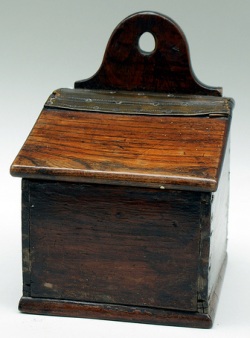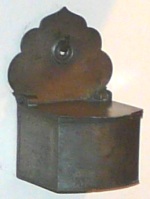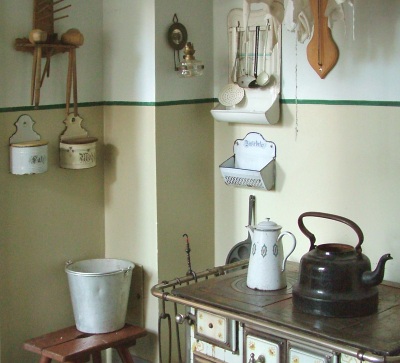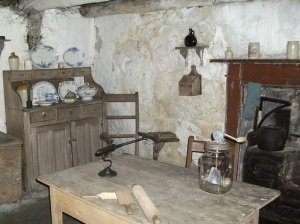
Hanging salt boxes used to be taken for granted in kitchens throughout northern Europe and colonial America. There they were, on the wall next to where you cooked.
The pictures on this page are all European, but salt boxes were an essential part of life for settlers in North America too. They pounded salt lumps with a mortar and pestle to make it ready for culinary use. Salt was important for preserving food as well as cooking it.
In colonial homes, free-flowing grains [of salt] began with placing the salt box near the fire for drying out lumps or removing a brick to make a salt niche.
Mary Ellen Snodgrass, Encyclopedia of Kitchen History

In damp, cool weather salt absorbs moisture from the air. Cooks in colder places used to help it stay dry by keeping it:
- near the fire or stove – most important
- in an airy place – hanging on the wall kept it away from damp
- covered – though not all salt boxes had a lid
The practical Pennsylvania Dutch housewife suspended a patterned and decorated covered salt box on the wall to contain enough crystals for preserving meat or as a granular extinguisher for dousing a kitchen fire.
Snodgrass, Encyclopedia, as above
Wooden salt boxes could be covered with decorative carving, sometimes as an engagement gift, painted, veneered, or left plain. Antique boxes that look simple may be very well crafted. Look at the quality of wood and joints, the hinging of the lid, the hanger, and the overall finish.
A salt box and a welcoming home

The salt box was full of meaning, over and above its practical importance. It was a symbol of hospitality in Germany, and suggested a well-run and comfortable home in Britain and Ireland too. Like salt itself the box might not be noticeable, and yet it was essential for cooking.
…her kitchen was…large, comfortable, and warm. …to the right hung a well-scoured salt-box…Over the door…were nailed, “for luck”, two horse-shoes that had been found by accident. In a little ” hole” in the wall, beneath the salt-box, lay a great bottle of holy water to keep the place purified…
Lianhan Shee, an Irish story collected by William Carleton, 1833
But if the salt box was unavailable the house was miserable and unwelcoming.
It was a very dark miserable place, very low, and very damp…The grate…was…screwed up tight, so as to hold no more than a little thin sandwich of fire. Everything was locked up; the coal-cellar, the candle-box, the salt-box, the meat-safe, were all padlocked…The pinched and meagre aspect of the place would have killed a chameleon.
Charles Dickens, Master Humphrey’s Clock, 1840-41
Salt box variations

Not all hanging boxes were wooden. You may see relatively modern ones in enamelware or earthenware with a wooden hanger and lid. Also see this highly decorative pewter salt box from before 1600.
Silver miniature or toy salt boxes: familiar domestic objects made in precious metal for fun.
Ceramic salt holders to sit in a niche or on a shelf were an alternative to boxes for some people. They often had a round opening in the side like this characteristically Scottish “saut bucket”.
Photos
Photographers credited in captions. Links to originals here: Victorian salt box, Polish salt box, German salt box, Scottish salt box. More picture info here
I would like to know the proper German or French name for a wall-mounted enameled drip pan/utensil rack. I found one at a thrift store a few years ago and I would like to know its proper name. Thank you.
LikeLike
My salt box is porcelain with blue windmills on it
Label says C.A.H. Germany
LikeLike
This was a really interesting article. Thank you!
LikeLike
very interesting article I love enamel pieces and kept seeing the salt wall tins
Thank you
LikeLike
Love salt varieties! Love the tradition of salt box! Thank you for this story! I found a ceramic beauty now more of a treasure! If you’re interested there is a beautiful old Irish story about …Love You Like Salt.
LikeLike
Story is not Irish as it has been told from many cultures. “Love you like meat loves salt”
LikeLike
Your website is so wonderful! I have just read several of your posts and I love how thorough and informed they are. I have come across wall mounted salt boxes many times and always wondered what they were for (if they were meant to be used in the kitchen or perhaps outside for salting snow) and quick google searches were pretty useless at finding any information. Then I find your article and it has everything I could possibly want to know about them! Thank you for being such a passionate person, understanding the daily and mundane objects of the past give great insight into life then and make history more relatable. Can’t wait to read more!
LikeLike
I would like to know if anyone knows of a reliable source to find the value of salt boxes? I would estimate I have about 80 of them that I’ve been collecting/gifted over the last few years.
LikeLike
Yes, these are old age components which are used to keep salt and I think most of us have seen this in their childhood time. Nice Post.
LikeLike